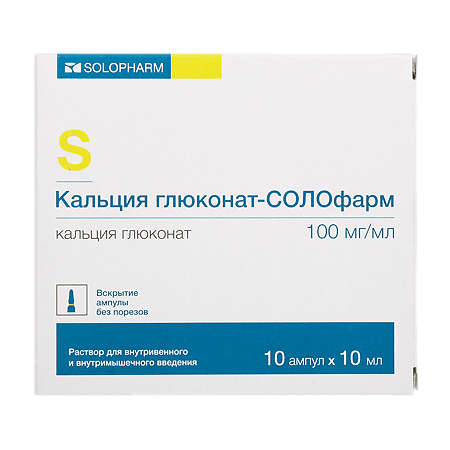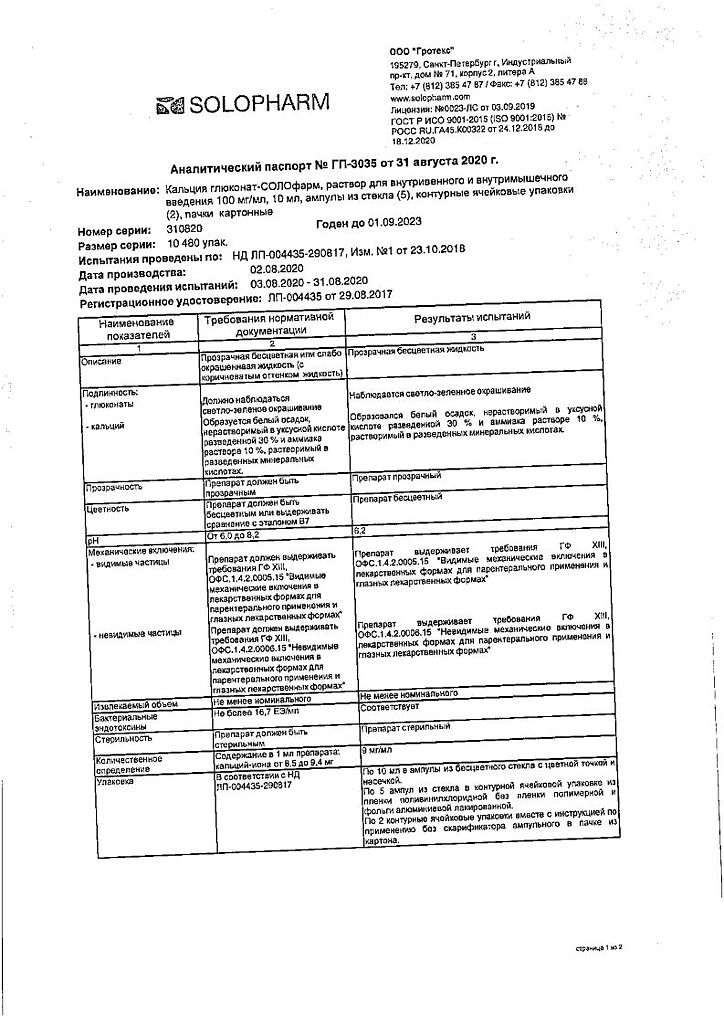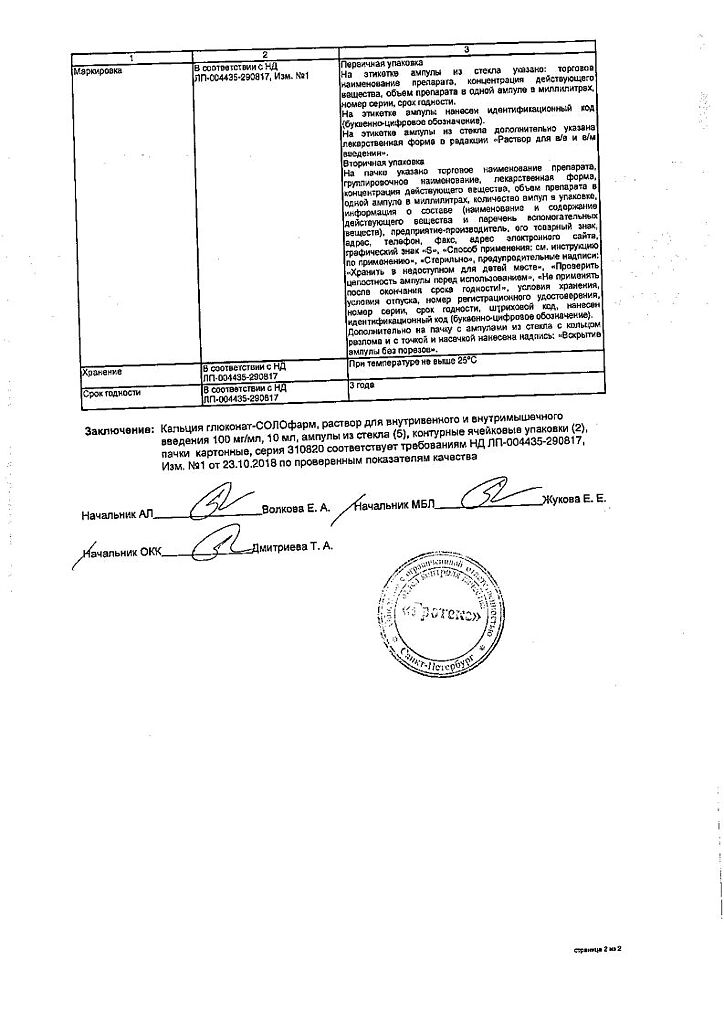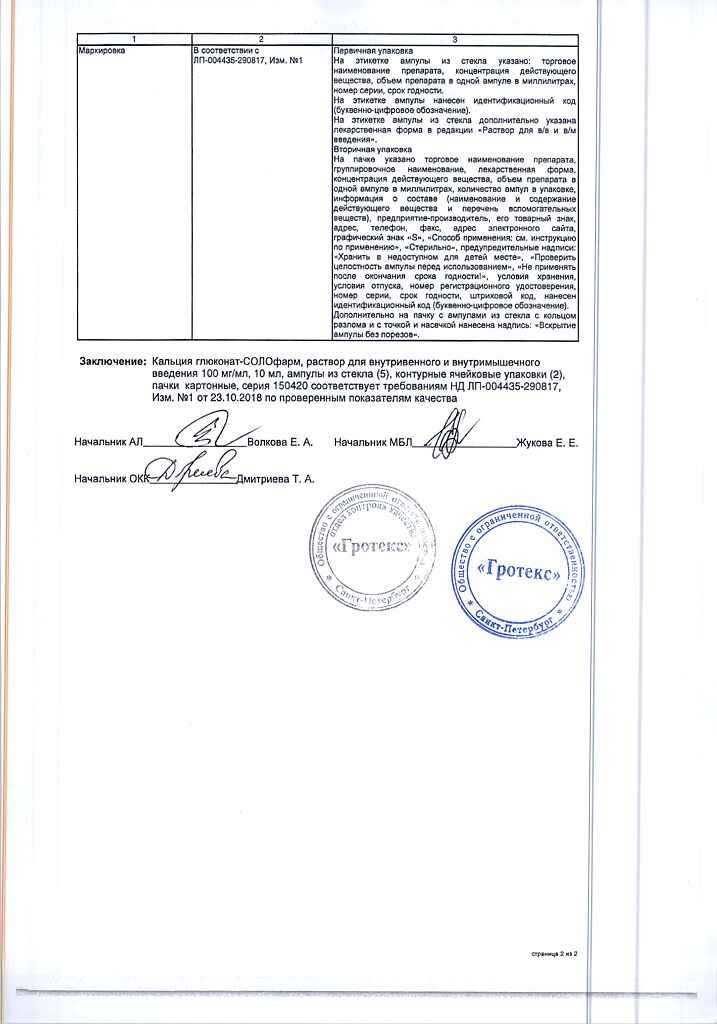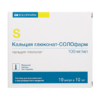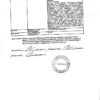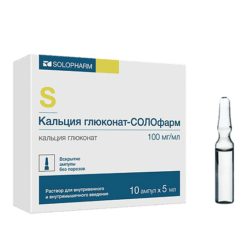No products in the cart.
Calcium gluconate-SOLOPHARM, 100 mg/ml 10 ml 10 pcs
€5.53 €4.61
Description
Pharmacotherapeutic group
Calcium-phosphorus metabolism regulator.
The ATC code: A12AA03
Pharmacological properties
Pharmacodynamics
The calcium drug replenishes the deficiency of calcium ions necessary for the process of transmission of nerve impulses, contraction of skeletal and smooth muscles, myocardial activity, formation of bone tissue, and blood clotting.
In intravenous administration it stimulates the sympathetic section of the autonomic nervous system, increases adrenal adrenal secretion.
Pharmacokinetics
After parenteral administration of calcium gluconate with blood flow is evenly distributed in all tissues and organs. In blood plasma calcium is both in bound form (complexed with proteins and with anions of organic and inorganic acids (bicarbonate, phosphate, lactate, calcium citrate)) and in free ionized form.
It penetrates the placental barrier and enters breast milk. It is eliminated from the body mainly by the kidneys.
Indications
Indications
Active ingredient
Active ingredient
Composition
Composition
1 ml of the drug contains:
Active ingredient:
Calcium gluconate monohydrate 94 mg
Assisted substances:
Calcium saccharate 5 mg
Injection water up to 1 ml
How to take, the dosage
How to take, the dosage
The normal serum concentration of total calcium is 2.25-2.75 mmol/l, or 4.45-5.5 sEq/l. Therapy with calcium gluconate is aimed at restoring normal plasma calcium concentration. Calcium-containing solutions should be administered slowly to minimize peripheral vasodilation and cardiac suppression.
The drug is heated to body temperature before administration. The drug is administered deeply intramuscularly or intravenously slowly (over 2-3 minutes), or dropwise, to avoid the possibility of local irritation or necrosis if the drug enters the perivascular tissues. Intravenous injections should be performed under close monitoring of heart rate and electrocardiogram, since bradycardia with vasodilation and arrhythmias may occur if calcium gluconate is administered too rapidly.
Intravenous administration may cause fever throughout the body, which passes quickly.
Because of the risk of local irritation, intramuscular injections should only be performed if intravenous injection is not possible. Intramuscular injections should be made deep enough into the muscle, preferably in the gluteal area. For obese patients, a longer needle should be selected to inject safely into the muscle rather than into the fatty tissue. If repeated injections are necessary, the injection site should be changed each time.
Interaction
Interaction
Symptoms of hypercalcemia: anorexia, nausea, vomiting, constipation, abdominal pain, polyuria, polydipsia, dehydration, muscle weakness, bone pain, renal calcification, drowsiness, hypersomnia, confusion, increased blood pressure, in severe cases – arrhythmia (up to heart failure) and coma.
Treatment: aimed at reducing the increased concentration of calcium in the blood plasma. Initial therapy includes rehydration, in severe hypercalcemia may require intravenous sodium chloride 0.9% solution infusion to increase the amount of extracellular fluid. Calcitonin may be used to decrease serum calcium concentration.
Furosemide may be used to increase calcium excretion, but “thiazide” diuretics should not be used because they may increase renal calcium absorption. Hemodialysis or peritoneal dialysis is performed if other measures are ineffective or if symptoms of hypercalcemia persist. Treatment of overdose is carried out under careful control of serum electrolyte concentration.
Special Instructions
Special Instructions
The drug is heated to body temperature before administration. The drug is injected deeply intramuscularly or intravenously slowly (within 2-3 minutes), or dropwise, to avoid the possibility of local irritation or necrosis if the drug enters the perivascular tissues. Intravenous injections should be performed under close monitoring of heart rate and electrocardiogram, since bradycardia with vasodilation and arrhythmias may occur if calcium gluconate is administered too rapidly.
Intravenous administration may cause fever throughout the body, which passes quickly.
Because of the risk of local irritation, intramuscular injections should only be performed if intravenous injection is not possible. Intramuscular injections should be made deep enough into the muscle, preferably in the gluteal area. For obese patients, a longer needle should be selected to inject safely into the muscle rather than into the fatty tissue. If repeated injections are necessary, the injection site should be changed each time.
Contraindications
Contraindications
Hypersensitivity to calcium gluconate and other drug components, hypercalcemia (including patients with hyperparathyroidism, hypervitaminosis D, decalcifying malignancies, renal failure, osteoporosis associated with immobilization, sarcoidosis, lactic-alkali syndrome (Burnett syndrome)), hypercalciuria, intoxication with cardiac glycosides, concurrent treatment with cardiac glycosides; For intramuscular administration – pediatric age.
With caution
. Dehydration, electrolyte disorders (risk of hypercalcemia), diarrhea, malabsorption syndrome, calcium nephrolithiasis (history), mild hypercalciuria, moderate chronic renal failure, common atherosclerosis, hypercoagulability, in elderly patients, especially in the presence of one or more of the above mentioned conditions, nephrocalcinosis, cardiovascular pathology, sarcoidosis, chronic heart failure, concomitant treatment with epinephrine. It is necessary to consult a physician before using the drug.
Side effects
Side effects
The incidence of side effects is directly related to the rate of administration and the dose of calcium gluconate. When properly administered, the frequency of their occurrence is 1/1000.
Cardiovascular system: decreased blood pressure, bradycardia, arrhythmia, vasodilation, circulatory collapse (including lethal), “flushes” of blood, most often with rapid administration.
Digestive system disorders: nausea, vomiting, diarrhea.
General disorders: feeling of warmth, sweating.
Disorders at the site of injection: with intramuscular injection – pain or erythema (⤠1/10, ⥠1/100), with violation of the technique of intramuscular injection – infiltration into fatty tissue with subsequent formation of abscess, thickening of tissues and necrosis; with intravenous injection – skin flushing, burning sensation or pain with possible development of tissue necrosis (with accidental perivascular injection).
A case of soft tissue calcification with subsequent possible skin lesions and necrosis due to calcium release from the vessel into the tissue has been reported.
Overdose
Overdose
Symptoms of hypercalcemia: anorexia, nausea, vomiting, constipation, abdominal pain, polyuria, polydipsia, dehydration, muscle weakness, bone pain, renal calcification, drowsiness, hypersomnia, confusion, increased blood pressure, in severe cases – arrhythmia (up to heart failure) and coma.
Treatment: aimed at reducing the increased concentration of calcium in the blood plasma. Initial therapy includes rehydration, in severe hypercalcemia may require intravenous sodium chloride 0.9% solution infusion to increase the amount of extracellular fluid. Calcitonin may be used to decrease serum calcium concentration.
Furosemide may be used to increase calcium excretion, but “thiazide” diuretics should not be used because they may increase renal calcium absorption. Hemodialysis or peritoneal dialysis is performed if other measures are ineffective or if symptoms of hypercalcemia persist. Treatment of overdose is carried out under careful control of serum electrolyte concentration.
Similarities
Similarities
Additional information
| Shelf life | 3 years. |
|---|---|
| Conditions of storage | Store at a temperature not exceeding 25 ° C. Store out of the reach of children. |
| Manufacturer | Grotex Ltd, Russia |
| Medication form | solution for injection |
| Brand | Grotex Ltd |
Other forms…
Related products
Buy Calcium gluconate-SOLOPHARM, 100 mg/ml 10 ml 10 pcs with delivery to USA, UK, Europe and over 120 other countries.

